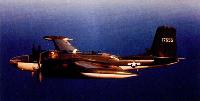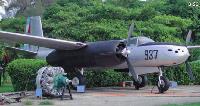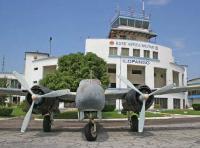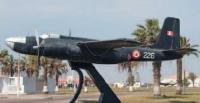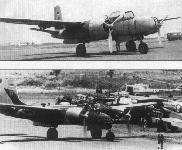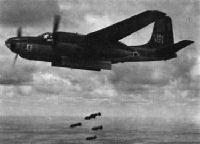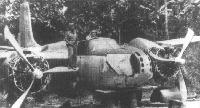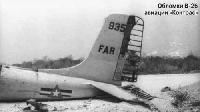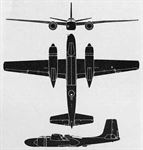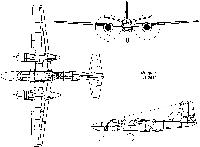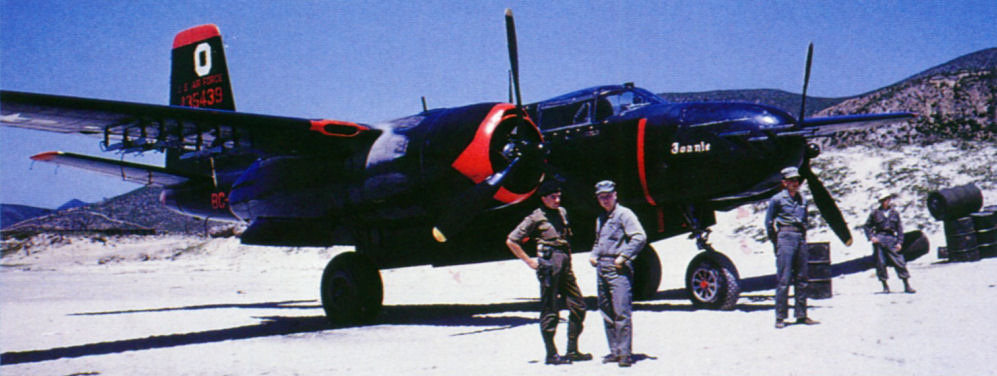
Описание
Страна : США
Год : 1942
Легкий бомбардировщик/штурмовик с экипажем из трех человек
A-26 / B-26 Invader
Легкий бомбардировщик-штурмовик, двухмоторный цельнометаллический моноплан. Шасси убирающееся, с носовой стойкой. Экипаж 3 человека. Спроектирован в КБ фирмы "Дуглас эйркрафт" под руководством Э.Хейнеманна и Р.Донована. Первый полет опытный образец XA-26 совершил 10 июля 1942 г. Серийное производство начато в сентябре 1943 г. Выпускался на заводах "Дуглас" в Лонг-Бич и Талсе. Всего построено 2452 экз.
Моторы R-2800-27/71, позднее (с серий B-45 и C-45) - R-2800-79.
В период Второй мировой войны состоял на вооружении только в США - с конца 1943 г.
Выпускались две основные модификации:
- A-26B, бомбардировщик-штурмовик с неостекленной носовой частью, основное вооружение 10x12,7 (с B-50- 16x12,7) с возможностью подвески 4x12,7 в контейнерах;
- A-26C, средний бомбардировщик с остекленным носом, основное вооружение 6x12,7 (с C-50 - 8x12,7) с возможностью подвески 4x12,7 в контейнерах.
В ходе серийного производства с серий B-30 и C-30 был введен новый фонарь пилотской кабины.
Первое боевое применение - в мае 1944 г. на Новой Гвинее. В сентябре того же года поступил на вооружение американских частей в Англии, в январе 1945 г. - в Италии. С июля 1945 г. использовался в боях в Китае и на островах Рюкю. A-26 сняли с производства в сентябре 1945 г. С вооружения ВВС США его сняли в 1945 г., Национальной гвардии - в 1972 г.
A-26B||
Размах:||21,35 м
Длина:||15,25 м
Моторы, количество х мощность:||2x2000 л.с.
Взлетная масса, максимальная:||16800 кг
Максимальная скорость:||570 км/ч
Практический потолок:||6800 м
Дальность:||5100 км
Описание:
- A-26 / B-26 Invader
- Douglas A-26 и B-26 Invader
Фотографии
-
Мир Авиации 1993-01 / И.Сеидов - Ночной заслон /Война в воздухе/
B-26B-2-DL Invader из 8-й эскадрильи 3-го бомбардировочного крыла. Корея, 1954г.
-
Мировая Авиация 112
A-26B-15-DT несет код "RC" бывшей 552-й бомбардировочной эскадрильи 386-й бомбардировочной группы, которая летала на самолетах B-26 Marauder. Самолет в апреле 1 945 года базировался в местечке Бомон-сюр-Ойз (Франция).
-
Авиация и Время 2003-01 / И.Сеидов - Ночные сражения в небе Кореи (2)
B-26C из 3-й бомбардировочной авиагруппы, середина 1952г.
-
АвиаМастер 2002-01 / М.Жирохов - "Инвэйдеры" охотились на "Львов" /Горячая точка/
B-26B, использовавшийся конголезскими ВВС для тренировки личного состава.
-
АвиаМастер 2002-01 / М.Жирохов - "Инвэйдеры" охотились на "Львов" /Горячая точка/
Один из B-26K "ВВС ЦРУ", на которых воевали в Конго кубинские наемники, 1966г.
-
Мировая Авиация 33
Французы использовали в Индокитае самолеты B-26B с установленным в носовой части фюзеляжей стрелковым вооружением и B-26RB, способные нести бомбовую нагрузку массой 2722 кг. Поначалу самолеты Invader применялись с высочайшей эффективностью, но потом они перешли к выполнению боевых заданий ночью, для чего их полностью перекрасили в черный цвет. Через 10 лет эти самолеты вновь появились в небе Вьетнама, но теперь они несли опознавательные знаки ВВС США.
-
Авиация и Время 2008-04 / А.Богданов, А.Котлобовский - Адью, Алжир! (2)
B-26B из бомбардировочной авиагруппы GB 2/91 "Гиень", Алжир, 1961г.
-
АвиаМастер 2002-04 / М.Жирохов, О.Моногону - Прощай, Биафра! Воздушная война в Нигерии, 1967-70гг. /Неизвестные страницы/
Один из двух биафрийских "Инвэйдеров" - RB-26P. Аэродром Энугу, август 1967г.
-
АвиаМастер 2003-03 / М.Жирохов, А.Котлобовский - Небесные войны Индонезии /Горячая точка/ (2)
Регистрационный номер: M-265 B-26 "Инвэйдер", состоявший на вооружении ВВС Индонезии в 1950-х годах.
-
АвиаМастер 2004-05 / В.Морозов, В.Антаков - Пылающий остров /Из истории воздушных войн/ (2)
Регистрационный номер: FAR915 "Инвэйдер" кубинских революционных ВВС, принимавший участие в боях на Плайя-Хирон.
-
Мир Авиации 1994-01 / В.Морозов - Самолеты над Заливом Свиней /Война в воздухе/
Регистрационный номер: FAR933 [6] B-26B Invader/FAR 933. На этом самолете в ходе боев на Плайя-Хирон летал Д.Л.Марреро. Сбитый B-26 с бортовым номером FAR 903 выглядел аналогично. Так же выглядели и "Инвэйдеры" "гусанос", но их бортовые номера неизвестны.
-
АвиаМастер 2004-05 / В.Морозов, В.Антаков - Пылающий остров /Из истории воздушных войн/ (2)
Регистрационный номер: FAR935 [2] "Инвэйдер" из состава ВВС "Бригады-2506" (радиопозывной "Горилла-2"), сбитый 18 апреля 1961 года над Плайя-Ларга.
-
АвиаМастер 2004-05 / В.Морозов, В.Антаков - Пылающий остров /Из истории воздушных войн/ (2)
Один из "инвэйдеров, на которых в Гватемале осуществлялась подготовка пилотов-наемников перед вторжением на Кубу. Самолет не несет никаких опознавательных знаков и регистрационных кодов.
-
Мировая Авиация 5
Ночной бомбардировщик Douglas B-26 Invader атаковал в Северной Корее самые разные цели - от передовых позиций пехоты до железнодорожных станций.
-
Мировая Авиация 63
B-26 из состава подразделения "Фарм Гейт" пилотировали поначалу пилоты, набранные при посредничестве ЦРУ.
Douglas B-26 Invader с подвешенными под крылом блоками НАР и контейнерами с напалмом выруливает на старт, аэродром Бьенхоа. После того как в 1964 году полеты B-26 запретили, "воздушные коммандос" получили самолеты Douglas A-7 Skyraider. -
АвиаМастер 2002-01 / М.Жирохов - "Инвэйдеры" охотились на "Львов" /Горячая точка/
Подготовка "Инвэйдера" к боевому вылету. На снимке хорошо видно, что обслуживанием самолетов занимался настоящий "интернационал" наемников.
-
История Авиации 2002-01 / Д.Кондратков - Расплавленное небо Вьетнама /Авиация в локальных войнах/ (4)
A-26K из состава 606-й эскадрильи специальных операций на авиабазе Накхон Фаном в Лаосе перед ночным боевым вылетом в район "Тропы Хо Ши Мина".
-
Авиация и Космонавтика 2019-06 / В.Морозов - Авиация во Вьетнамской войне (2)
Противопартизанский штурмовик B-26K
-
Авиация и Космонавтика 2019-07 / В.Морозов - Авиация во Вьетнамской войне (3)
Самая продвинутая противопартизанская модификация «Инвейдера», использовавшаяся во Вьетнаме - B-26K. Середина 1960-х гг.
-
Мировая Авиация 186
64-17640 - первый из 40 B-26K Counter Invader, модифицированных компанией "On Mark Engineering". Особенности - носовая часть без остекления, восемь подкрыльевых узлов подвески и концевые топливные баки.
-
Air Pictorial 1999-07
Регистрационный номер: N7705C [2] Highlights of the recent Dutch Dakota Association open days at Schiphol-East were the former South African Air Force DC-4 PH-DDS, and a ‘new’ A-26C owned by Dutch warbird enthusiast Richard Nivo, trading as Historic Invader Aviation. N7705C, c/n 44-35710, has undergone 10,000 hr of restoration since it arrived in Holland in August 1998, and after receiving a permit to fly up to 30 hr during 1999, made its initial flight at Amsterdam on May 8. It now awaits airshow invitations.
-
Aeroplane Monthly 1998-10 / M.Oakey, T.Harmsworth - Vintage news
Регистрационный номер: N7705C [2] Douglas Invader N7705C/44-35710 transited through Keflavik on August 13, 1998 en route from California to its new home in Holland. It stopped at Duxford on the 14th and arrived at Schiphol on the 17th.
-
Мировая Авиация 112
Приспособленные для решения новых задач B-26K получили новые серийные номера. Основным отличием модели "K" были топливные баки на законцовках крыла, хотя самолеты имели и более мощные двигатели, и усиленное крыло.
-
Air Enthusiast 2003-09 / D.Gordon - Sabres with 'Eyes'
In 1953, at the end of the Korean War, the 67th TRW flew the RB-26, RF-80 and T-33 as well as the RF-86 Sabre. All the wing's aircraft are seen in the company of a Marine recce Banshee.
Другие самолёты на фотографии: Lockheed RF-80A / FP-80 - США - 1945Lockheed T-33A - США - 1948McDonnell F2H Banshee - США - 1947North American RF-86 - США - 1951
-
Air Enthusiast 2001-07 / D.Gordon - TAC Recon Masters (1)
RB-26B, 30th TRS at Hahn in the winter of 1954.
-
Aviation Historian 34 / M.Napier - The pale blue line
A busy scene at Kimpo circa late 1951, with Gloster Meteors of the Royal Australian Air Force’s No 77 Sqn in the distance and glass-nosed all-black Douglas B-26 Invaders to the right. The Australians began the Korean conflict with P-51 Mustangs, but acquired the Meteor F.8s from the UK and deployed 22 at Kimpo from July 1951.
Другие самолёты на фотографии: Gloster Meteor F.Mk.8 / FR.Mk.9 - Великобритания - 1948
-
Aviation Historian 10 / D.Gordon - The Polka-Dot Ridge Runners
Bearing the name Linda and Bobby Jr on the engine cowling, F-51D 45-11613 is seen here in a line of Mustangs at K-14 Kimpo in 1951. On strength with the 45th TRS, this machine was written off during an accident at Itazuke airbase in Japan on November 2 that year. Note the Douglas RB-26s of the 12th TRS in the background.
Другие самолёты на фотографии: North American P-51D Mustang - США - 1944
-
Air Enthusiast 1998-09 / F.Mormillo - Tanker 55
44-35323 in natural metal finish, but with 12th TRS, 67th TRG markings, en route to an airshow appearance.
-
Aeroplane Monthly 1981-12
Our dynamic photograph of the Planes of Fame Douglas A-26C Invader was taken this year by FRANK B. MORMILLO.
-
Air Enthusiast 1998-09 / F.Mormillo - Tanker 55
RB-26C 44-35323 flying with its stablemate, Planes of Fame B-25J 44-30423
Другие самолёты на фотографии: North American B-25J Mitchell / PBJ-1G - США - 1943
-
Aeroplane Monthly 1986-12
FRANK B. MORMILLO'S photograph depicts The Air Museum's RA-26C Invader and B-25J Mitchell in formation over Chino, California in May 1986. The Invader is being flown by Don Lykins, and the Mitchell by Joe Haley and Merrill Wein.
Другие самолёты на фотографии: North American B-25J Mitchell / PBJ-1G - США - 1943
-
Air Enthusiast 1998-09 / F.Mormillo - Tanker 55
Planes of Fame President Steve Hinton and crew chief Kyle Rohman flying 44-35323 in company with Dick Bertea’s Douglas AD-4N Skyraider during The Air Museum’s November 1997 monthly ‘Special’, this one commemorating the warbirds of the Korean War.
Другие самолёты на фотографии: Douglas AD / A-1 Skyraider - США - 1946
-
Мировая Авиация 5
Самыми необычными B-26 Invader во время корейской войны были изображенные ниже самолеты, оснащенные расположенным над бомбовым отсеком инфракрасным детектором. Такие машины обнаруживали по тепловому излучению передвигавшиеся ночью поезда и части противника, сбрасывали осветительные бомбы, благодаря которым шедшие во втором эшелоне обычные B-26 легко атаковали освещенные цели.
-
Aeroplane Monthly 1996-04 / M.Oakey - Vintage news
Регистрационный номер: N7079G Still languishing at Holman Field, St Paul’s, Minneapolis, is all-black Douglas A-26 Invader N7079G Bar-Belle Bomber. Bought by UK-based warbird enthusiast Barbel Abela from Conrad Yelvington in the USA in November 1991, the former On-Mark Marksman executive conversion of the World War Two twin-engined bomber had corrosion and a mainspar crack rectified at Brownsville, Texas, and then visited the UK in July 1992 as part of the Round-the-World Air Race. It returned to the USA via Moscow to visit the Oshkosh fly-in, and then flew to Holman Field for an airshow appearance. During its display routine there on August 9, 1992, a loud crack from the port wing was quickly followed by a precautionary landing. Three-and-a-half years later the A-26 is still at Holman with its port wing off.
-
Изд-во Schiffer / S.Markman & B.Holder - One-of-a-kind research aircraft
Регистрационный номер: N9417H One of the variable stability B-26s as it appeared in later life in Calspan markings. This particular aircraft crashed at Edwards Air Force Base in the early 1980s.
-
АвиаМастер 2004-05 / В.Морозов, В.Антаков - Пылающий остров /Из истории воздушных войн/ (2)
"Инвэйдер" в гаванском музее. Самолет окрашен так же, как бомбардировщики FAL во время битвы на Плайя-Хирон.
-
Aviation Historian 4 / P.Davidson - Off the Beaten Track...
The 1940s-vintage air terminal at Ilopango Airport that was the nation’s national and international gateway until 1970. This rather weary Douglas A-26 Invader is one of the larger exhibits at the museum.
-
Air International 1984-10 / ??? - Colombia's Air Arm
Регистрационный номер: FAC2504 The Douglas B-26 Invader entered service in the early 'fifties with the Escuadron de Bombardeo at Palanquero.
-
Авиация и Космонавтика 2014-07 / Д.Пичугин - Военно-воздушные силы страны Инков /Зарубежные ВВС/
Бомбардировщик B-26C «Инвэйдер» ВВС Перу, установленный на авиабазе Писко
-
Aviation Historian 37 / L.Hellstrom - Sweden's Carribean connection
In perpetual fear of being deposed, the Trujillo government spent heavily on defence, particularly the air arm. As a result, the AMD’s mix of aircraft types was truly astonishing; this panorama shows Vampire F.1s, Thunderbolts and Mustangs as well as Douglas B-26s, Curtiss C-46s, a Lockheed Lodestar and a PBY Catalina.
Другие самолёты на фотографии: Consolidated PBY Catalina - США - 1935Curtiss-Wright C-46 / CW-20 Commando - США - 1940De Havilland Vampire / D.H.100 - Великобритания - 1943Lockheed Lodestar L-18/C-59/R5O - США - 1939North American P-51D Mustang - США - 1944Republic P-47D-25 / P-47N Thunderbolt - США - 1943
-
Air International 1981-09 / Fighter A to Z
The sole Douglas XA-26A night fighter prototype.
-
Моделист-Конструктор Бомбардировщики Второй мировой войны
A-26B-10 с ранним типом фонаря пилотской кабины
-
Aeroplane Monthly 1980-11 / News Spotlight
The Cavalier Air Force Douglas A-26 Invader over Biggin Hill seconds before destruction during the Battle of Britain air display on September 21, 1980.
-
Jane's All the World Aircraft 1946 / 03 - All the world's aeroplanes
The Douglas A-26B Invader Three-seat Attack Bomber (two Pratt & Whitney R-2800-71 engines).
-
Моделист-Конструктор Бомбардировщики Второй мировой войны
A-26B-15 в полете
-
Jane's All the World Aircraft 1947 / All the world's aeroplanes
The Douglas A-26B Invader Attack Bomber (two 2,000 h.p. Pratt & Whitney R.2800-71 engines).
-
Air Pictorial 1957-08 / Air Pictorial's photo-review
Регистрационный номер: N66661 A beautifully finished ex-U.S.A.F. Douglas A-26B Invader is used for business executive transportation in the United States. Registration N66661.
-
Aeroplane Monthly 1978-07 / News Spotlight
Among the many and varied types on show at the International Air Fair, Biggin Hill, on May 20-21, 1978, undoubtedly the most unusual item was the Douglas A-26 Invader, which is to be based at Duxford.
-
Air Enthusiast 1999-07 / L.Hellstrom - Air War in Paradise
One of the B-26Bs of the second batch of three Invaders flown to Manado in mid-May 1958, seen at Clark Air Base before delivery. Unlike the first batch these aircraft had eight-gun noses and a natural metal finish.
-
Air Enthusiast 1999-07 / L.Hellstrom - Air War in Paradise
Another and equally anonymous B-26B at Clark, awaiting ferrying to the CIA base at Manado. It was painted overall black without any discernible markings.
-
Air Enthusiast 1999-07 / L.Hellstrom - Air War in Paradise
One of the first Invaders to be used in the Indonesian operation, B-26B 44-34376, is being run up at Clark Air Base on March 20, 1958, before delivery. Note the wing guns.
-
Aeroplane Monthly 1988-10 / M.Oakey - Grapevine
Регистрационный номер: N167B Making its UK airshow debut at Coventry's “Wings of Victory" display on August 6-7, 1988 was Douglas A-26B Invader N167B/44-34602, owned and flown by Anders Saether of the Scandinavian Historic Flight. The Coventry show was lavish and varied, but attendance was dreadful with a mere 4,000 on the Saturday and 6,000 on the Sunday. The company which staged the show subsequently collapsed with colossal debts of around million.
-
Jane's All the World Aircraft 1946 / 03 - All the world's aeroplanes
The Douglas A-26B Invader Three-seat Attack Bomber (two Pratt & Whitney R-2800-71 engines).
-
Aeroplane Monthly 1986-01 / P.Chinnery - The Air War over Vietnam (1)
Douglas B-26B Invader 44-35703. This “Ranch Hand” aircraft was shot down over South Vietnam on November 24, 1963.
-
Мировая Авиация 30
В первые годы войны во Вьетнаме B-26 зарекомендовал себя весьма эффективным самолетом. Бомбардировщики пилотировались американскими экипажами, но по политическим соображениям несли опознавательные знаки ВВС Южного Вьетнама.
-
Мировая Авиация 5
После налета на позиции северокорейских войск в мае 1951 года бомбардировщики Invader из 731-й бомбардировочной эскадрильи 452-го крыла бомбардировочной авиации возвращаются на базу в Японии.
The B-26B of the 452nd Bomb Wing in all-black finish as used in Korea. -
Авиация и Космонавтика 1999-11 / М.Никольский - Авиация специального назначения (1)
Ветерану второй мировой и корейской войн - B-26 также нашлась работа в качестве "ганшипа"...
-
Jane's All the World Aircraft 1966 / 02 - Aircraft
On Mark B-26K Counter Invader (two 2,500 hp Pratt & Whitney R-2800-103W engines), with six 750-lb napalm tanks and two 230-gal jettisonable fuel tanks under wings
-
Jane's All the World Aircraft 1964 / 01 - Aircraft
On Mark Counter-Invader (two 2,500 hp Pratt & Whitney R-2800-103W engines)
-
Aeroplane Monthly 1980-01 / J.Kucera - Mojave Magnificent
Регистрационный номер: N22939 Wally McDonnell’s A26K N22939 The Mojave Kid rounds a pylon.
-
Air Enthusiast 1999-07 / L.Hellstrom - Air War in Paradise
The two B-26Cs kept on stand-by at Clark Air Base received a makeshift dark green camouflage paint job. In the event they were never used in Indonesia and instead went to Taiwan.
-
Aeroplane Monthly 1989-02 / H.Levy - Invader in detail
Регистрационный номер: N8036E [2] N8036E parked at Allaire Airport, en route to Texas for the addition of a ventral turret and an all-black Korean War night bomber colour scheme.
-
Air Enthusiast 1972-01 / Model enthusiast
A-26C in the all-metall finish applicable to the World War II period.
-
Aeroplane Monthly 1989-02 / H.Levy - Invader in detail
Регистрационный номер: N8036E [2] Douglas B-26 Invader N8036E/44-35696 takes off from Allaire Airport, New Jersey.
-
Jane's All the World Aircraft 1980 / Encyclopedia of Aviation - Aircraft A-Z - v3
Douglas A-26C/B-26C Invader.
-
Aeroplane Monthly 1988-05 / Douglas A-26C Invader 44-35323 /Preservation Profile/
Invader 44-35323 with original A-26C glass nose and dorsal turret installed.
-
Aeroplane Monthly 1978-08 / News Spotlight
A fine study of the A-26 Invader at Bassingbourn on May 27, 1978.
-
Мировая Авиация 186
Invader получил боевое крещение в 1944 году - летчики 386-й бомбардировочной группы летали на A-26C (ближние к камере - с подкрыльевыми пушками) и A-26B против целей на континентальной части. Код "RU" принадлежит 554-й бомбардировочной эскадрилье.
-
Air Enthusiast 2007-07 / D.Gordon - Last of the Best /Post-war combat/ (1)
An RF-80A in company with its stablemate at Spangadahlem, an RB-26 of the 1st TRS, 10th TRW.
Другие самолёты на фотографии: Lockheed RF-80A / FP-80 - США - 1945
-
АэроХобби 1994-02 / А.Котлобовский - Двадцать лет в боях (История боевого применения истребителя МиГ-15) /Авиация в локальных конфликтах/ (1)
Бомбардировщик B-26C Invader из состава 729-го BS
-
Авиация и Время 2002-06 / И.Сеидов - Ночные сражения в небе Кореи (1)
Опробывание двигателей на одном из "Инвейдеров". Весна 1952г.
-
Jane's All the World Aircraft 1966 / 02 - Aircraft
Photographic-reconnaissance version of the B-26K Counter Invader, with glazed nose
-
Мир Авиации 2005-02 / В.Мартианов - Шестой континент, пятый океан... /Страницы истории/ (2)
Аэродром американской станции Мак-Мердо. Слева направо: B-26 "Инвейдер", UH-34, R4D (флотское обозначение C-47), P2V "Нептун", "Бивер", R4D-8 (он же LC-117, он же "Super DC-3"). На переднем плане - дом Роберта Скотта (находится внутри строения). 25 октября 1958 года.
Другие самолёты на фотографии: De Havilland Canada DHC-2 Beaver - Канада - 1947Douglas DC-3 / C-47 Skytrain/С-53 Skytrooper / Dakota - США - 1935Lockheed Neptune P2V - США - 1945Sikorsky CH-34 / S-58 Choсtaw - США - 1954
-
Air Enthusiast 2001-07 / D.Gordon - TAC Recon Masters (1)
An RB-26 30th TRS, 66th TRW, Sembach, 1954. This aircraft carries the yellow chevrons on the underwing tanks as well as on the tail
-
Air Pictorial 1998-03 / D.Gordon - Destroyer deployers
An all-black Douglas RB-26C, 44-35765, of the 42nd TRS, 10th TRW, seen at RAF Bovingdon in 1955. Three large ventral radomes are supplemented by an array of blade aerials on the rear fuselage.
-
Air Pictorial 1956-01 / Air Pictorial's photo-review
Photographed at Bovingdon recently, an unusual Douglas RB-26C-46-DT Invader (44-35762), first to be noted in the U.K. with an O-serial. Various bulges may be seen under the nose and rear fuselage.
-
Air Enthusiast 2001-07 / D.Gordon - TAC Recon Masters (1)
Douglas RB-26 Invader 44-35375 of the 30th TRS, 66th TRW, at Sembach, 1954.
-
Aeroplane Monthly 1991-05 / R.Paver - Tico 1991
Регистрационный номер: N9150 Douglas A-26 Invader N9150/44-34766 Georgia Invader is operated by Randall Porter and David Brady and based at Cartersville in Georgia. It was flown down to Tico in company with Porter’s North American B-25J Mitchell N5833B Georgia Girl and a Grumman Tracker, and was photographed from the Mitchell over Florida’s East Coast on March 7, 1991.
-
Air Pictorial 1956-05 / Photo-review
A rare bird in Europe, photographed recently at Kastrup, a U.S. Navy target-towing (and drone-towing) Douglas JD-1 Invader. Colour scheme "Midnite" blue and yellow. Note radar in nose.
-
Air Pictorial 1958-07 / Photo Review
ARCTIC CIRCLERS. What makes these two photographs of otherwise familiar U.S.A.F. types noteworthy is the fact that the aircraft illustrated are residents of the Far North - Ladd A.F.B.. Alaska. Photo: An air-gunnery target tug attached to Ladd A.F.B., is this Douglas TB-26C-45-DT Invader (USAF.0-435756; Buzz No. BC-756), with yellow-painted wingtips and tail assembly.
-
Air Pictorial 1961-10
Регистрационный номер: N7953C A new Beech-designed and built air refuelling system has passed initial evaluation studies by the U.S. Navy. Extension of the system is through electrical release of the drogue which pulls out a 40-ft. length of flexible hose. This in turn forces out the boom.
Другие самолёты на фотографии: Morane-Saulnier MS.760 Paris - Франция - 1954
-
Air International 1982-08
Регистрационный номер: C-GHLI, N9594Z Some of the fire-fighting fleet of Conair Aviation, seen towards the end of 1981. They include the Douglas A-26C C-GHLI (fleet No 329, c/n 27702, ex N9594Z). The Conair fleet includes nine Trackers, 12 A-26 Invaders and seven DC-6B water-bombers.
-
Aeroplane Monthly 1988-05 / Douglas A-26C Invader 44-35323 /Preservation Profile/
Invader 44-35323 still in its firefighting configuration in 1981.
-
Air Enthusiast 1998-09 / F.Mormillo - Tanker 55
Planes of Fame Chairman of the Board Don Lykins taking 44-35323 off for its very first public performance at Chino, California, August 1980.
-
Air Enthusiast 1998-09 / F.Mormillo - Tanker 55
44-35323 displaying at Chino, still wearing its Conair ‘Tanker 55’ colours.
-
Air Enthusiast 1998-09 / F.Mormillo - Tanker 55
Kyle Rohman (left), Invader crew chief and museum pilot Kevin Eldridge with RB-26C 44-35323.
-
Jane's All the World Aircraft 1947 / All the world's aeroplanes
The Douglas XA-26F Invader which was fitted with an auxiliary General Electric I-16 gas-turbine in place of the rear defensive armament amidships.
-
Jane's All the World Aircraft 1964 / 01 - Aircraft
On Mark Marketeer, an executive transport conversion of the Douglas B-26
-
Мировая Авиация 186
Регистрационный номер: N190Y Ряд компаний переоборудовал Invader в корпоративные самолеты, в их числе были "L. В. Smith" и "On Mark Engineering". Последняя предлагала заказчикам изображенный здесь Marksman.
-
Jane's All the World Aircraft 1980 / Encyclopedia of Aviation - Aircraft A-Z - v5
Регистрационный номер: N300V On Mark Marksman.
-
Jane's All the World Aircraft 1966 / 02 - Aircraft
Innovations on the On Mark Marksman B-26 conversion include a redesigned and pressurised fuselage
-
Jane's All the World Aircraft 1964 / 01 - Aircraft
Smith Tempo II, an executive transport conversion of the Douglas B-26 bomber
-
Авиация и Время 2008-04 / А.Богданов, А.Котлобовский - Адью, Алжир! (2)
Французы значительные надежды возлагали на бомбардировщики B-26 "Инвейдер"
-
Мировая Авиация 27
Поставленные из США самолеты B-26 Invader являлись самым потенциально эффективным оружием, которое французы могли использовать под Дьен Бьен Фу. На фотографии: смешанная группа из B-26B и B-26C, последние легко отличить по остекленным носовым частям фюзеляжей. Самолеты принадлежат эскадрилье G.В 1/25 "Tunisie".
-
Мировая Авиация 186
Данные Invader из французских ВВС - B-26B (ближний к камере) и B-26C из GB1/19 "Gascogne"- сфотографированы во время операции "Picardie", война в Индокитае, 1953 год.
-
Мировая Авиация 186
Франция активно использовала B-26 в колониальных войнах в Индокитае и Алжире. Восемь установленных в носовой части B-26B пулеметов калибра 12,7 мм - отличное средство для атаки наземных целей.
-
История Авиации 2000-04 / М.Райдер - Пылающее небо Кохинхины /Неизвестная война/
Полученные французами "Инвейдеры" имели значительный боевой потенциал, обусловленный мощным вооружением, но полностью реализовать его в тяжелых климатических условиях Индокитая было трудно. Как правило, экипажи этих штурмовиков, помимо шести 127-мм НУРСов, брали не более тонны бомб.
-
Air Pictorial 1957-02
French Air Force Invaders which are becoming increasingly common these days, originate, like this example ex-44-35953, at U.S. storage depots. Many more are yet to come and the numbers carried are evidently the "last three" of the original U.S.A.F. serial.
-
Air Enthusiast 1998-01 / R.Niccoli - Atlantic Sentinels
Taken at BA9 Luanda in 1975, this B-26 Invader of Esquadra 91 shows the late camouflage used in the African war, a wrap-around antiradiation olive-green with low-visibility markings.
-
Air Pictorial 1976-03 / J.Wegg - Angola - a last look?
Portuguese A.F. Beech 18 2520 (foreground), two B-26 Invaders (7105 natural finish) and Noratlas 6404
Другие самолёты на фотографии: Beechcraft Model 18 / C-45 Expeditor - США - 1937Nord Nord 2500 Noratlas - Франция - 1949
-
Авиация и Космонавтика 2019-05 / В.Морозов - Авиация во Вьетнамской войне (1)
Линейка основных самолетов, которые поставлялись VNAF. Слева направо: L-19 (Helio Courier ???), T-28, B-26B, C-47, C-46 и C-123. Авиабаза Тан Шон Нят, начало 1960-х гг.
Другие самолёты на фотографии: Curtiss-Wright C-46 / CW-20 Commando - США - 1940Douglas DC-3 / C-47 Skytrain/С-53 Skytrooper / Dakota - США - 1935Fairchild C-123 Provider - США - 1949Helio Courier - США - 1949North American T-28 Trojan - США - 1949
-
АвиаМастер 2003-03 / М.Жирохов, А.Котлобовский - Небесные войны Индонезии /Горячая точка/ (2)
Индонезийские "Инвэйдеры" на военных аэродромах.
-
АвиаМастер 2003-03 / М.Жирохов, А.Котлобовский - Небесные войны Индонезии /Горячая точка/ (2)
Регистрационный номер: M-261 "Инвейдер" - экспонат индонезийского авиамузея.
-
АвиаМастер 2002-04 / М.Жирохов, О.Моногону - Прощай, Биафра! Воздушная война в Нигерии, 1967-70гг. /Неизвестные страницы/
"Инвэйдеры" биафрийских ВВС. Машины относятся к разным модификациям, причем, обе - разведывательные: вверху - RB-26P, внизу - B-26R.
-
Air International 1985-07
Douglas A-26C operated by the Forca Aerea Brasileira
-
Aviation Historian 27 / S.Rivas - South of the Border
The Fuerza Aerea de Chile (FACh) operated a total of 38 Douglas B-26B/Cs from 1954. This FACh B-26B, “846”, was originally 44-35937, and, after a long spell as a gate guardian at El Bosque air base, near Santiago, it was moved in 1997 to Jackson Barracks Military Museum in New Orleans.
-
Aviation Historian 38 / L.Hellstrom - The CIA's defection deception
Регистрационный номер: FAR933 [6] The original Cuban B-26 number 933 was a glazed-nose B-26C brought to Miami by a defecting pilot in December 1958, just before the revolution. The fin still bears FAEC rather than FAR titles, and the aircraft is fitted with gun turrets and underwing gun packs. The forward fuselage is adorned with an “Indian’s Head” motif.
-
Aviation Historian 38 / L.Hellstrom - The CIA's defection deception
Регистрационный номер: FAR933 [6] The official CIA history relating to Project JMFURY states: “Both pilot and aircraft were to be reamed, steamed, dry-cleaned, sterilised and sanitised in order to make it appear that a legitimate defection from Castro’s Cuba had occurred”. Note the gun-equipped nose of the B-26B (of which the FAR had few, if any, at that time) and the feathered starboard propeller, supposedly owing to “battle damage”.
-
Aviation Historian 38 / L.Hellstrom - The CIA's defection deception
Регистрационный номер: FAR933 [6] Douglas B-26 Invader “933" in its Fuerza Aerea Revolucionaria (FAR) markings at Miami on April 15, 1961, following its participation in the CIA’s Project JMFURY. Press photographers were encouraged to take as many photographs as they wanted, with a view to spreading the message that Cuban pilots were attacking their own airfields and defecting to the USA.
-
Aviation Historian 38 / L.Hellstrom - The CIA's defection deception
Регистрационный номер: FAR933 [6] The USA's ambassador to the United Nations, Adlai Stevenson, inspects a press photograph of the B-26 at Miami. Kept in the dark regarding how much involvement the Americans had in the Bay of Pigs operations, Stevenson was unaware of Project JMFURY and suffered profound embarrassment as a result.
-
Aviation Historian 38 / L.Hellstrom - The CIA's defection deception
Регистрационный номер: FAR933 [6] Customs agents remove the ammunition from the B-26 at Miami. The prerevolution Fuerza Aereas Ejercito de Cuba (Cuban Army Air Force - FAEC) had taken delivery of the first of its 18 Invaders in November 1956. The air arm was renamed the Fuerza Aerea Revolucionaria following Castro’s takeover in 1959.
-
Aeroplane Monthly 1989-02 / H.Levy - Invader in detail
William Dodds, the Invader’s pilot, is a Flying Tigers transport captain.
-
Aeroplane Monthly 1989-02 / H.Levy - Invader in detail
The B-26's top turret, fitted with a pair of 0.50in machine-guns and controlled by the gunner from his station beneath the glazing.
-
Aeroplane Monthly 1989-02 / H.Levy - Invader in detail
The Invader's Pratt & Whitney R-2800-79 Double Wasps drive Hamilton Standard propellers.
-
Aeroplane Monthly 1989-02 / H.Levy - Invader in detail
The detail shot show the B-26's undercarriage noseleg.
-
Aeroplane Monthly 1989-02 / H.Levy - Invader in detail
The detail shot show the B-26's single-pilot cockpit.
-
Aeroplane Monthly 1987-02 / M.Oakey - Grapevine
Регистрационный номер: N4806E The fuselage of Douglas A-26C Invader sat Rockford, Illinois before its journey across the Atlantic last year. It is now being restored at Southend, and is to be finished in USAF Korean War markings of the 3rd Bombardment Wing - black overall with red flashes.
-
Aeroplane Monthly 2000-02 / M.Oakey, T.Harmsworth - News
No longer a pigeon playpen, Douglas Invader 44-34659 has been removed from a Canadian rooftop and is now under restoration.
-
Авиация и Космонавтика 2003-02 / М.Никольский - Кубинка: история и современность
В прицеле Григория Геся B-26
-
Мировая Авиация 186
Самолеты Invader из состава американской 5-й ВА сыграли заметную роль в корейской войне. Данная машина, получившая повреждения от стрелкового огня, садится "на брюхо".
-
АвиаМастер 2003-03 / М.Жирохов, А.Котлобовский - Небесные войны Индонезии /Горячая точка/ (2)
"Цэрэушный" "Инвэйдер", захваченный индонезийскими войсками после разгрома суматранских сепаратистов.
-
Air Enthusiast 1999-07 / L.Hellstrom - Air War in Paradise
The B-26 Invader crashed by Connie Seigrist, after the Mapanget airfield in Manado was captured by government troops
-
АвиаМастер 2004-05 / В.Морозов, В.Антаков - Пылающий остров /Из истории воздушных войн/ (2)
Еще один экспонат музея "Плайя-Хирон" - двигатель со сбитого пилотами FAR "Инвэйдера" наемников.
-
Авиация и Космонавтика 2015-02 / В.Ильин - ВВС Кубы
Регистрационный номер: FAR935 [2] Обломки B-26 авиации «Контрас»
-
Авиация и Время 2003-01 / И.Сеидов - Ночные сражения в небе Кореи (2)
Обломки сбитого в ночном бою B-26
-
Aeroplane Monthly 1980-11 / News Spotlight
Don Bullock, the pilot, and six passengers were killed when the A-26 failed to recover from a low-level barrel roll and crashed outside the airfield boundary.
-
Мир Авиации 1993-01 / И.Сеидов - Ночной заслон /Война в воздухе/
Американский самолет, принимавший участие в ночных опреациях Корейской войны 1950-53гг.: Douglas B-26 Invader
-
Jane's All the World Aircraft 1946 / 03 - All the world's aeroplanes
The Douglas A-26 Invader.
Тип фотографий
- Все фото (138)
- Боковые проекции (13)
- Цветные фото (29)
- Ч/б фото (81)
- Кабина (1)
- Реставрация (2)
- Обломки (9)
- Схемы (3)























